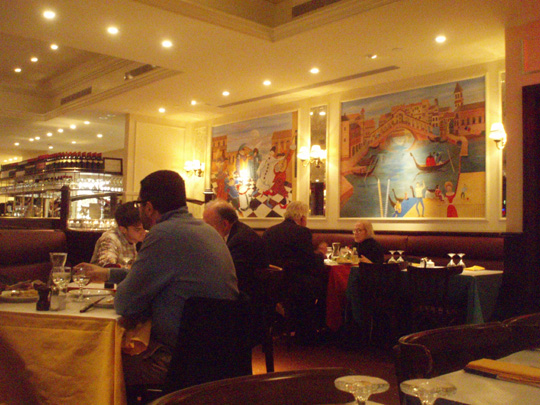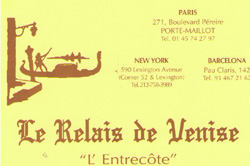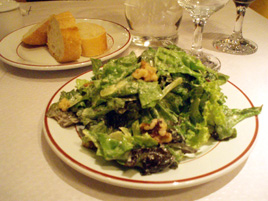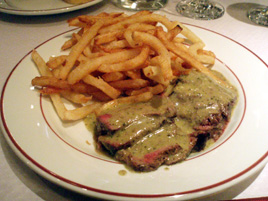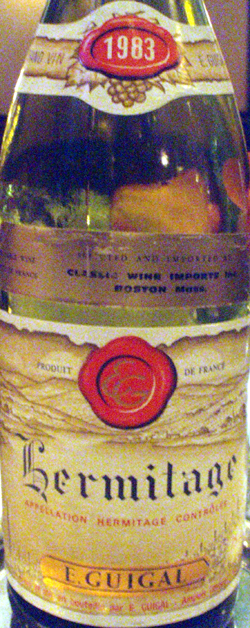Note: Convivio closed in March 2011, along with its sister restaurant Alto on the same day, due to unspecified “business circumstances.”
*
 Michael White is obviously not the only chef in this town with multiple restaurants. But the three he has are probably the most similar.
Michael White is obviously not the only chef in this town with multiple restaurants. But the three he has are probably the most similar.
Alto, Convivio, and Marea are all upscale Italian New York Times three-star restaurants. There are slight differences in focus—northern Italian, southern Italian, and seafood respectively—but the menus share a strong stylistic similarity.
There is nothing like, for instance, the huge difference between Daniel and Café Boulud, or between Jean Georges and Perry St.
On the bill, however, there is a huge difference, with four-course prix fixes of $89, $79, and $59 at Marea, Alto, and Convivio respectively. Location has something to do with it—Central Park South for Marea, midtown for Alto, Tudor City for Convivio. The expensive seafood ingredients imported for Marea are clearly a factor.
But after four visits to Marea, I am not yet quite persuaded that you get your money’s worth for $89. It is clearly a very good restaurant, or I wouldn’t have returned. But for $40 less per person, we had a terrific meal at Convivio last week that was better than any one of my meals at Marea. The only drawback is that you have to traipse to Tudor City, which is a moderate inconvenience.
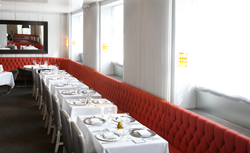 Convivio is in the space that had been L’Impero. Eric Asimov awarded three stars (when Scott Conant was the chef), but Frank Bruni demoted it to two, finding the food inconsistent, and complaining about “lugubrious” décor “evoking the upholstered interior of a very large coffin.” Ouch!
Convivio is in the space that had been L’Impero. Eric Asimov awarded three stars (when Scott Conant was the chef), but Frank Bruni demoted it to two, finding the food inconsistent, and complaining about “lugubrious” décor “evoking the upholstered interior of a very large coffin.” Ouch!
White and owner Chris Cannon took the critique to heart. If ever there were a makeover tailor-made to Bruni’s specifications, this was it. They brightened up the space, lowered the cost of the prix fixe, and added inexpensive tapas-like starters called sfizi.
Voila! Convivio was a three-star restaurant.
Convivio was never very high on our to-do list, mainly because we no longer trusted Bruni to evaulate Italian restaurants correctly. This time, perhaps he got it right.
You can order à la carte here, as at all of the Cannon–White restaurants. The sfizi are $4–7, antipasti $10–16, primi $23–25, secondi $26–35, desserts $11–15. But at $59 the prix fixe is a much better deal. There is only one dish that carries a supplement: the steak, which at $35 is the most expensive entrée. On the prix fixe, you’re basically getting the antipasto at half price and the dessert for free.


What can I say? We loved almost everything. Testa (above left), a deep-fried pork terrine, was complemented beautifully by a fried egg. Polipo (above right), or grilled octopus, was tender and smoky.

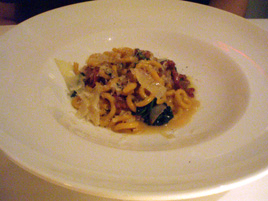
Garganelli (above left) came with a seppia & shrimp sausage, zucchini leeks, and peccorino; Gramigna (above right) with duck sausage, broccoli rabe, sage, and marsala.
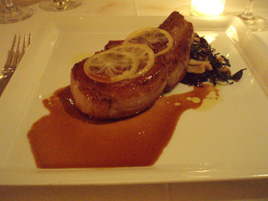
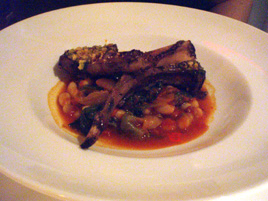
Maiale (above left), or a pork chop, was large enough to feed all of Tudor City. As good as it was, I had no intention of sharing.
Grilled lamb chops (above right) were delightful, but they were undermined by salsa verde, escarole, tomato and beans, which were far too overbearing and unsubtle.
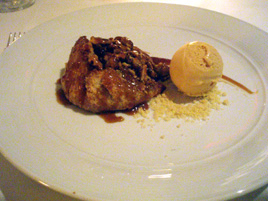

Heather Bertinetti, the young pastry chef at all three of the Cannon–White restaurants, is a real find. She hasn’t disappointed me yet. Crostata di Mela (above left) was an irresistible crumble of spiced apples, walnuts, and caramel gelato. Brasato d’Ananas (above right) made a hit out of vanilla braised pineapple, coconut custard, and mango sorbet.
Service was polished and professional. I especially appreciated the sommelier, who, when I asked for a recommendation at $60 or less, went all the way down to $45. It was a terrific choice too (the 2001 Majara), and on top of that he decanted it and offered us a copy of the label.
The restaurant wasn’t quite full, but business was certainly brisk. (When I called to confirm, a recording warned that our table would be forfeit if we were more than fifteen minutes late: ugh!) We may have lucked into one of the better tables, a two-top on the restaurant’s upper level, with no one nearby. Some of the tables are a bit more cramped than that.
No one doubts that Michael White is an elite chef. I’ve had my ups and downs at Marea, but I will likely return there somewhat regularly, as it is much more conveniently located, and I still have a lot of confidence in Chef White. But if you can get to Tudor City, Convivio may be the best way to experience his cuisine.
Convivio (45 Tudor City Place at 42nd Street, Tudor City)
Food: ***
Service: ***
Ambiance: ***
Overall: ***
 Tuesday, November 17, 2009 at 06:25PM
Tuesday, November 17, 2009 at 06:25PM  Livanos Family,
Livanos Family,  Oceana in
Oceana in  Review Preview
Review Preview 































